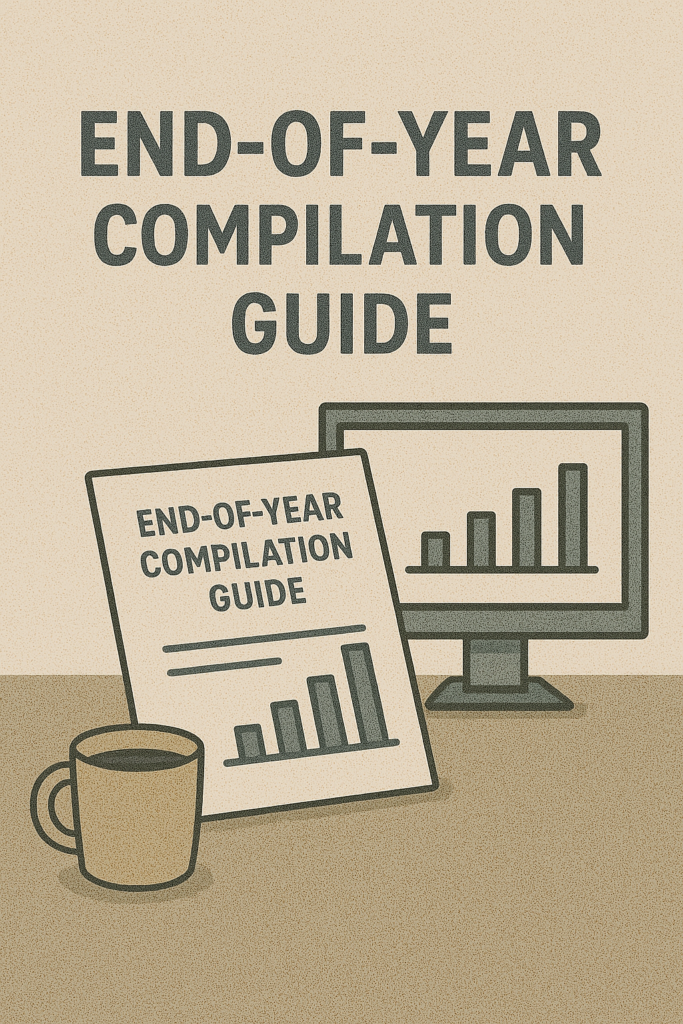Closing the fiscal year isn’t just a checkbox—it’s a critical opportunity to assess your financial health and prepare for what’s ahead. This end-of-year compilation guide is designed to help you complete your books, organize key documents, and produce accurate financial reports that support compliance, audits, and strategic planning.
Whether you’re a small business, a freelancer, or a growing corporation, these procedures are essential to end the year strong and enter the new one with confidence.
Why Is an End-of-Year Compilation Guide Important?
Finalizing your financials requires more than clicking “export.” Done correctly, a year-end compilation:
- Ensures that records are complete and accurate
- Reduces the risk of IRS penalties or missed tax deductions
- Helps stakeholders, lenders, or investors evaluate performance
- Lays the foundation for next year’s budget and financial goals
Without a structured approach, you risk errors, oversights, and missed opportunities.
📌 Learn how our team simplifies year-end financial prep
Key Components of a Proper End-of-Year Compilation
1. Reconcile Accounts Before You Compile
Before you begin compiling reports, make sure your books are accurate:
- Reconcile all bank and credit card accounts
- Match merchant processor transactions
- Identify and correct discrepancies in the general ledger
- Confirm that all invoices and bills are accounted for
This step is non-negotiable—it sets the tone for the accuracy of your entire compilation.
📘 Our experts can handle monthly reconciliations for you
2. Organize and Categorize All Transactions
One of the most overlooked parts of the end-of-year compilation guide is reviewing transactions for accuracy and consistency:
- Ensure expenses are properly categorized
- Separate personal from business expenses
- Review payroll entries and tax liabilities
- Adjust depreciation and amortization schedules
Well-organized data simplifies audits and accelerates tax prep.
3. Prepare Core Financial Reports
Once accounts are clean and up to date, generate the following:
- Profit and Loss Statement (P&L): Shows revenues and expenses
- Balance Sheet: Details assets, liabilities, and equity
- Cash Flow Statement: Tracks the inflow and outflow of money
These reports provide a snapshot of your business performance and are critical for both tax and planning purposes.
🧩 Talk to our team about custom financial reporting
4. Review Receivables and Payables
As part of this year-end compilation guide, don’t forget to assess your cash position:
- List outstanding invoices (Accounts Receivable)
- Record unpaid bills (Accounts Payable)
- Evaluate customer payment trends
- Decide whether to write off bad debts
Clean AR and AP lists give you a true picture of liquidity.
5. Evaluate Fixed Assets and Inventory
For product-based businesses, inventory counts and asset reviews are key:
- Conduct physical inventory counts
- Adjust for shrinkage, damage, or obsolescence
- Update depreciation schedules on fixed assets
- Add new purchases to your asset register
This step improves reporting accuracy and tax deduction tracking.
6. Finalize Tax-Related Documents
A complete end-of-year compilation must include tax readiness:
- Calculate and record estimated tax payments
- Review deductions and credits
- Update W-9 and 1099 data for contractors
- Verify employee compensation for W-2 issuance
📲 Need tax support? Let Marcos Timana EA handle it
7. Back Up and Archive All Records
Once your data is compiled and reports are generated:
- Back up your accounting software files
- Store digital and paper records securely
- Ensure access for your accountant or tax professional
- Prepare a summary package for investors or internal review
Additional Tips for Using This End-of-Year Compilation Guide
- Set calendar reminders every December
- Assign roles within your team for financial tasks
- Use cloud-based tools for easy collaboration
- Schedule a review meeting with your accountant or EA
- Start preparing your new year’s budget based on the compiled data
🗓️ Consistency is key to a smoother, more accurate financial close.
Final Thoughts on the End-of-Year Compilation Guide
Following a structured end-of-year compilation guide is more than a compliance task—it’s a strategic move that improves accuracy, readiness, and insight. It ensures you’re tax-prepared, audit-proof, and well-positioned to grow in the coming year.
📞 Ready to close your books with clarity? Schedule a consultation today or follow us on Facebook and Instagram for financial tips and updates.
Frequently Asked Questions
1. What is an end-of-year compilation in accounting?
It’s the process of finalizing, organizing, and reviewing all financial data and reports before closing the fiscal year.
2. Why is a year-end compilation guide important?
It ensures accuracy, supports compliance, simplifies tax prep, and provides insights for planning the next year.
3. Can small businesses skip formal compilations?
Even small businesses benefit from structured year-end financial reviews for budgeting, reporting, and tax readiness.
4. What tools help streamline year-end compilation?
QuickBooks, Xero, and working with an Enrolled Agent or accountant like Marcos Timana EA ensure efficiency and accuracy.




 por
por